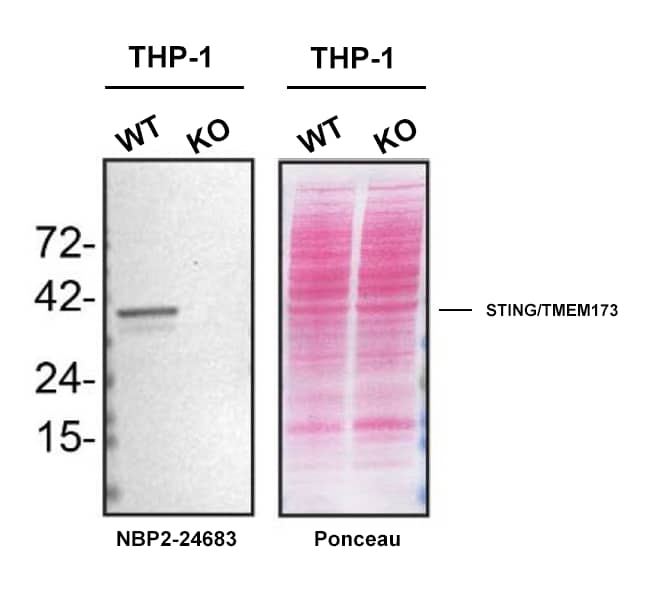STING/TMEM173 Antibody - BSA Free
Novus Biologicals, part of Bio-Techne | Catalog # NBP2-24683

![Western Blot: STING/TMEM173 AntibodyBSA Free [NBP2-24683] Western Blot: STING/TMEM173 AntibodyBSA Free [NBP2-24683]](https://resources.bio-techne.com/images/products/STING-TMEM173-Antibody-Western-Blot-NBP2-24683-img0014.jpg)
Conjugate
Catalog #
Key Product Details
Validated by
Knockout/Knockdown
Species Reactivity
Validated:
Human, Mouse, Canine, Primate, Rhesus Macaque
Cited:
Human, Mouse, Rat
Predicted:
Bovine (94%). Backed by our 100% Guarantee.
Applications
Validated:
ELISA, Flow Cytometry, Immunocytochemistry/ Immunofluorescence, Immunohistochemistry, Immunohistochemistry-Frozen, Immunohistochemistry-Paraffin, Immunoprecipitation, Knockout Validated, Western Blot
Cited:
Block/Neutralize, ELISA, Flow Cytometry, IF/IHC, Immunocytochemistry/ Immunofluorescence, Immunohistochemistry-Frozen, Immunohistochemistry-Paraffin, Immunoprecipitation, Western Blot
Label
Unconjugated
Antibody Source
Polyclonal Rabbit IgG
Format
BSA Free
Concentration
1.0 mg/ml
Product Specifications
Immunogen
Partial synthetic peptide made to an internal portion of human STING/TMEM173 (between amino acids 310-360) [UniProt Q86WV6]
Reactivity Notes
Opossum, Zebrafish (83%), Xenopus (72%), Rat (88%).
Clonality
Polyclonal
Host
Rabbit
Isotype
IgG
Theoretical MW
42 kDa.
Disclaimer note: The observed molecular weight of the protein may vary from the listed predicted molecular weight due to post translational modifications, post translation cleavages, relative charges, and other experimental factors.
Disclaimer note: The observed molecular weight of the protein may vary from the listed predicted molecular weight due to post translational modifications, post translation cleavages, relative charges, and other experimental factors.
Scientific Data Images for STING/TMEM173 Antibody - BSA Free
Western Blot: STING/TMEM173 AntibodyBSA Free [NBP2-24683]
Western Blot: STING/TMEM173 Antibody [NBP2-24683] - STING/TMEM173 expression was induced in human breast MDA-MB-231 cells followed by Western blotting using STING/TMEM173 Antibody antibody (1:1000). Only one specific band at an apparent molecular mass of 37 kDa was observed. Image from verified customer review.Immunocytochemistry/ Immunofluorescence: STING/TMEM173 Antibody - BSA Free [NBP2-24683]
Immunocytochemistry/Immunofluorescence: STING/TMEM173 Antibody [NBP2-24683] - RH-30 cells were fixed for 10 minutes using 10% formalin and then permeabilized for 5 minutes using 1X PBS + 0.05% Triton X-100. The cells were incubated with STING/TMEM173 Antibody at 2 ug/mL overnight at 4C and detected with an anti-rabbit DyLight 488 (Green) at a 1:500 dilution. Alpha Tubulin Antibody (DM1A) (NB100-690) was used as a co-stain at a 1:1000 dilution and detected with an anti-mouse Dylight 550 (Red) at a 1:500 dilution. Nuclei were counterstained with DAPI (Blue). Cells were imaged using a 40X objective.Western Blot: STING/TMEM173 AntibodyBSA Free [NBP2-24683]
Western Blot: STING/TMEM173 Antibody [NBP2-24683] - Total protein from THP-1, HT-29, U2OS cells and human spleen was separated on a 12% gel by SDS-PAGE, transferred to PVDF membrane and blocked in 5% non-fat milk in TBST. The membrane was probed with 2.0 ug/ml STING/TMEM173 Antibody in 1% non-fat milk in TBST and detected with an anti-rabbit HRP secondary antibody using chemiluminescence.Applications for STING/TMEM173 Antibody - BSA Free
Application
Recommended Usage
ELISA
reported in scientific literature (PMID 34905508)
Flow Cytometry
1-5 ug/million cells
Immunocytochemistry/ Immunofluorescence
5 - 10 ug/ml
Immunohistochemistry
1:100 - 1:300
Immunohistochemistry-Frozen
reported in scientific literature (PMID 33745949)
Immunohistochemistry-Paraffin
1:100 - 1:300
Immunoprecipitation
Validated for Immunoprecipitation from YCharOS Inc. (ycharos.com)
Knockout Validated
Validated for Knockout from YCharOS Inc. (ycharos.com)
Western Blot
1 - 2 ug/ml
Reviewed Applications
Read 1 review rated 5 using NBP2-24683 in the following applications:
Formulation, Preparation, and Storage
Purification
Peptide affinity purified
Formulation
PBS
Format
BSA Free
Preservative
0.02% Sodium Azide
Concentration
1.0 mg/ml
Shipping
The product is shipped with polar packs. Upon receipt, store it immediately at the temperature recommended below.
Stability & Storage
Store at 4C short term. Aliquot and store at -20C long term. Avoid freeze-thaw cycles.
Background: STING/TMEM173
References
1. Patel, S., & Jin, L. (2019). TMEM173 variants and potential importance to human biology and disease. Genes and Immunity. https://doi.org/10.1038/s41435-018-0029-9
2. Jounai, N., Kobiyama, K., Takeshita, F., & Ishii, K. J. (2013). Recognition of damage-associated molecular patterns related to nucleic acids during inflammation and vaccination. Frontiers in Cellular and Infection Microbiology. https://doi.org/10.3389/fcimb.2012.00168
3. Xiao, T. S., & Fitzgerald, K. A. (2013). The cGAS-STING Pathway for DNA Sensing. Molecular Cell. https://doi.org/10.1016/j.molcel.2013.07.004
4. Kato, K., Omura, H., Ishitani, R., & Nureki, O. (2017). Cyclic GMP-AMP as an Endogenous Second Messenger in Innate Immune Signaling by Cytosolic DNA. Annual Review of Biochemistry. https://doi.org/10.1146/annurev-biochem-061516-044813
5. Crowl, J. T., Gray, E. E., Pestal, K., Volkman, H. E., & Stetson, D. B. (2017). Intracellular Nucleic Acid Detection in Autoimmunity. Annual Review of Immunology. https://doi.org/10.1146/annurev-immunol-051116-052331
Long Name
Stimulator of Interferon Genes Protein/Transmembrane protein 173
Alternate Names
ERIS, MITA, MPYS, NET23, TMEM173, anti-STING, human STING, mouse STING
Gene Symbol
STING1
UniProt
Additional STING/TMEM173 Products
Product Documents for STING/TMEM173 Antibody - BSA Free
Product Specific Notices for STING/TMEM173 Antibody - BSA Free
This product is for research use only and is not approved for use in humans or in clinical diagnosis. Primary Antibodies are guaranteed for 1 year from date of receipt.
Loading...
Loading...
Loading...
Loading...
Loading...
Loading...
![Immunocytochemistry/ Immunofluorescence: STING/TMEM173 Antibody - BSA Free [NBP2-24683] Immunocytochemistry/ Immunofluorescence: STING/TMEM173 Antibody - BSA Free [NBP2-24683]](https://resources.bio-techne.com/images/products/STING-TMEM173-Antibody-Immunocytochemistry-Immunofluorescence-NBP2-24683-img0017.jpg)
![Western Blot: STING/TMEM173 AntibodyBSA Free [NBP2-24683] Western Blot: STING/TMEM173 AntibodyBSA Free [NBP2-24683]](https://resources.bio-techne.com/images/products/STING-TMEM173-Antibody-Western-Blot-NBP2-24683-img0011.jpg)
![Immunohistochemistry-Paraffin: STING/TMEM173 Antibody - BSA Free [NBP2-24683] Immunohistochemistry-Paraffin: STING/TMEM173 Antibody - BSA Free [NBP2-24683]](https://resources.bio-techne.com/images/products/STING-TMEM173-Antibody-Immunohistochemistry-Paraffin-NBP2-24683-img0006.jpg)
![Immunohistochemistry-Paraffin: STING/TMEM173 Antibody - BSA Free [NBP2-24683] Immunohistochemistry-Paraffin: STING/TMEM173 Antibody - BSA Free [NBP2-24683]](https://resources.bio-techne.com/images/products/STING-TMEM173-Antibody-Immunohistochemistry-Paraffin-NBP2-24683-img0007.jpg)
![Flow Cytometry: STING/TMEM173 Antibody - BSA Free [NBP2-24683] Flow Cytometry: STING/TMEM173 Antibody - BSA Free [NBP2-24683]](https://resources.bio-techne.com/images/products/STING-TMEM173-Antibody-Flow-Cytometry-NBP2-24683-img0020.jpg)
![Flow Cytometry: STING/TMEM173 Antibody - BSA Free [NBP2-24683] Flow Cytometry: STING/TMEM173 Antibody - BSA Free [NBP2-24683]](https://resources.bio-techne.com/images/products/STING-TMEM173-Antibody---BSA-Free-Flow-Cytometry-NBP2-24683-img0021.jpg)
![Immunocytochemistry/ Immunofluorescence: STING/TMEM173 Antibody - BSA Free [NBP2-24683] Immunocytochemistry/ Immunofluorescence: STING/TMEM173 Antibody - BSA Free [NBP2-24683]](https://resources.bio-techne.com/images/products/STING-TMEM173-Antibody-Immunocytochemistry-Immunofluorescence-NBP2-24683-img0015.jpg)
![Flow Cytometry: STING/TMEM173 Antibody - BSA Free [NBP2-24683] Flow Cytometry: STING/TMEM173 Antibody - BSA Free [NBP2-24683]](https://resources.bio-techne.com/images/products/STING-TMEM173-Antibody-Flow-Cytometry-NBP2-24683-img0012.jpg)
![Flow Cytometry: STING/TMEM173 Antibody - BSA Free [NBP2-24683] Flow Cytometry: STING/TMEM173 Antibody - BSA Free [NBP2-24683]](https://resources.bio-techne.com/images/products/STING-TMEM173-Antibody-Flow-Cytometry-NBP2-24683-img0016.jpg)


